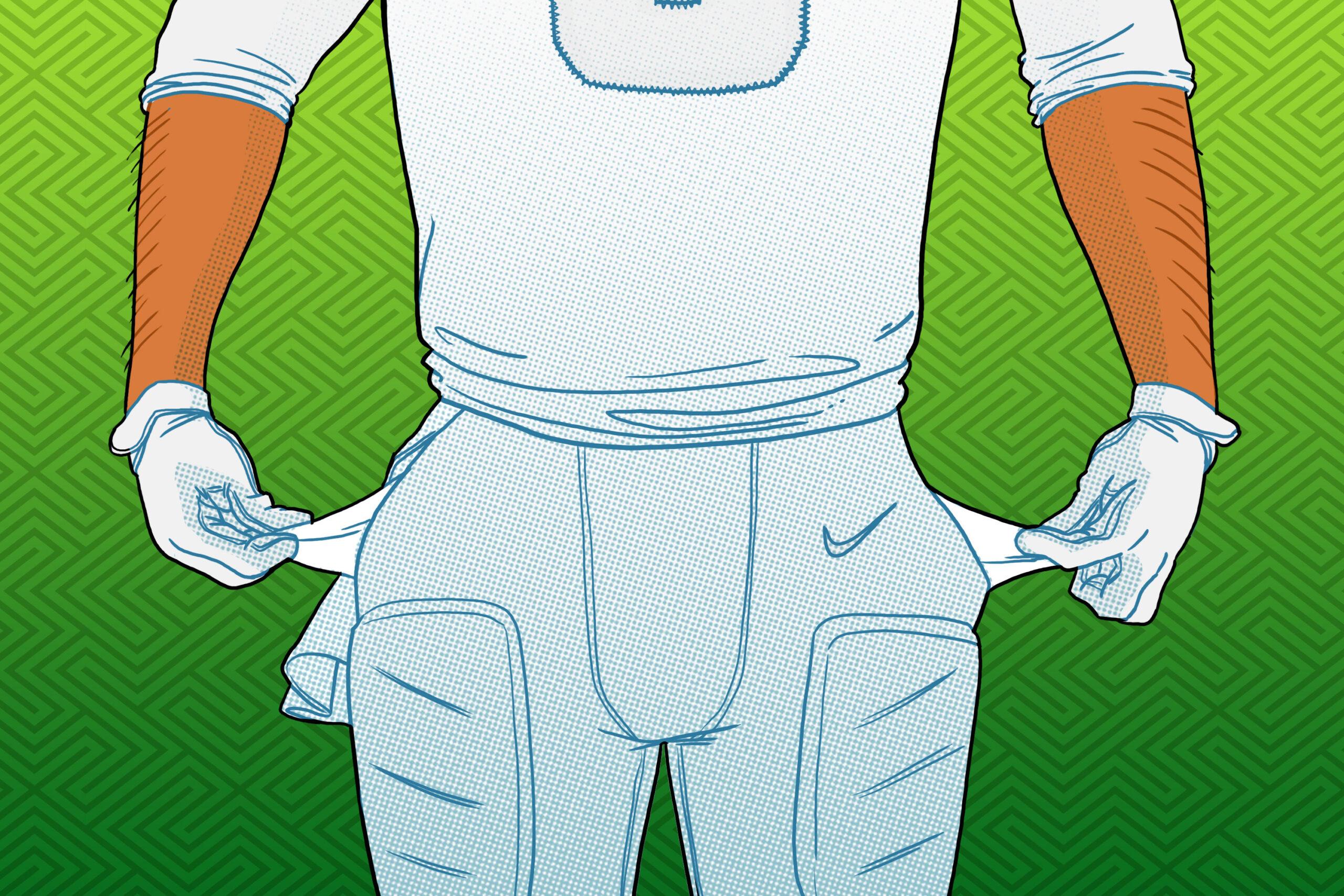
Owning a major professional sports franchise looks like a blast. First off, pro sports teams are fantastic investments, as appreciating assets pumped full of cash by lavish broadcast deals. Even if they don’t make a gigantic profit year-to-year, the value of an NBA or NFL franchise is constantly rising, which means the owner always has the option to sell for a profit. But they’re also great vehicles for plutocrats to satisfy a thirst for celebrity. By buying the Yankees, George Steinbrenner went from an unknown Cleveland shipping impresario to not only a billionaire, but also a nationally famous billionaire.
For these reasons, joining the exclusive club of major sports owners is an expensive proposition. Billionaire Bruce Sherman shelled out $1.2 billion to buy the moribund Miami Marlins, while the NHL is charging a $650 million expansion fee to the owners of the new Seattle franchise. Even buying into MLS costs $150 million these days, 15 times what it cost in 2005. Football, unsurprisingly, is an even more expensive proposition: The last NFL expansion franchise, the Houston Texans, paid a $700 million entry fee all the way back in 2002.
Of course, buying into an existing league isn’t the only option—a far riskier approach is to start a whole new one, which is what a group of investors led by TV and film producer Charlie Ebersol did when they started the Alliance of American Football, a nascent gridiron league that began play two weeks ago. But building a whole league from scratch is risky; just 10 days after the AAF opened its doors, Carolina Hurricanes owner Tom Dundon invested $250 million in the league and became its new chairman, amid reports that it had failed to meet its payroll obligations in Week 1. (Ebersol later denied that it was in danger of missing payroll.)
During an interview on the ESPN on Ice podcast on Tuesday, Dundon explained that he had the opportunity to invest in the AAF before play started, but held off because he was concerned about the quality and appearance of the football product. But after seeing the AAF in action, he changed his mind and bought in.
“I provide capital, and they have bills to pay,” Dundon said.
All of this is happening so quickly that it’s worth taking a moment to consider who Tom Dundon is, and what exactly his $250 million investment has bought him.
Dundon is a relative newcomer to sports ownership, having bought the NHL’s Hurricanes for $420 million just 13 months ago. He made his money by founding Drive Financial Services, a Texas-based auto loan company, in the 1990s, when he was only in his 20s. In 2006, Dundon sold a controlling interest in the company to Spanish financial giant Banco Santander for $651 million, keeping a 10 percent stake in the firm, now called Santander Consumer USA, for himself.

Santander Consumer, like Drive Financial before it, deals in subprime car loans: high-risk, high-interest loans to people whose financial history makes them undesirable to larger, more conservative lenders. Like subprime mortgages, these car loans are often bundled into bonds and sold to other financial entities as an investment, at a great profit to Santander Consumer.
But subprime car loans are more common than subprime mortgages; not everyone needs to buy a house, but the overwhelming majority of Americans need a car to get to work. That means that not only are more high-risk borrowers interested in subprime car loans, they’re also more likely to prioritize car payments over rent or a mortgage payment. The higher demand for car ownership allows lenders like Santander Consumer to charge interest rates three times what prime buyers could get from a traditional bank or credit union, and even with a record number of Americans more than 90 days behind on their car loans, default rates are still less than 5 percent.
Subprime car lending is an extremely profitable business, and Dundon, one of the first big investors in the market, made a killing off it. He’s used that initial profit to buy into real estate, healthcare, and entertainment companies; in 2011 he invested in Topgolf, and now owns 55 percent of the company. But while money can buy just about anything, it doesn’t necessarily guarantee fame. One way to transform wealth into celebrity, as Steinbrenner, Jerry Jones, Mark Cuban, and numerous others have learned, is to get involved in sports.
In 2014, Dundon cofounded Dallas’s Trinity Forest Golf Club, which opened its gates two years later with a course co-designed by two-time Masters champion Ben Crenshaw. In 2018, Dundon’s course bagged its first PGA Tour event, the AT&T Byron Nelson. That same year, Dundon purchased the Hurricanes. Within months, Dundon demoted and then fired the team’s GM, Ron Francis. Francis, a former Hurricanes captain and Hockey Hall of Famer, is immensely popular in the area and remains a minority owner of the club. As owner of the Hurricanes, Dundon has put himself front and center, frequently commenting on and involving himself in hockey operations issues. While other owners are content to sit in the background and cash the checks, Dundon has been more like his fellow Dallas billionaire Cuban, always part of the action.
One imagines he’ll be similarly active and visible as chairman of the AAF, which unlike any of the four major pro sports leagues, owns all eight of its constituent teams. To what end—apart from the obvious ends of profit and prestige—remains unclear.
While owning a sports team is a near-foolproof enterprise, starting a league from scratch is something of a sucker’s bet. It’s possible to build a new league to fill a previously unserved niche and succeed: MLS and the WNBA are good examples of this. Even the Arena Football League has lasted more than 30 years in one form or another, despite going bankrupt and canceling the 2009 season.
But challenging an established league cartel in a sport that’s already popular is a different proposition. The last startup league to muscle out or even achieve parity with its rival league was the BAA, now the NBA, which was founded in 1946. And the rival NBL and ABL of the 1940s were mom-and-pop operations compared to the modern NFL. Since then, the best-case scenario for a challenger league is the ABA (basketball), WHA (hockey), and AFL (football). All of those leagues operated for about a decade before forcing a merger or having several of their member clubs purchased by the established league in their sport. That’s the best-case scenario, and even that hasn’t happened since the NHL-WHA merger of 1979.
But unlike its predecessors, and defunct operations like the USFL, UFL, and original XFL, the AAF has set out from the start as a feeder league. Its schedule doesn’t overlap with the NFL’s, and only two of its eight teams play in a city with an existing NFL franchise. The AAF is explicitly a developmental pipeline from which the NFL can pluck coaches and players; the standard three-year contract AAF players sign has an out clause that allows them to leave for the NFL.
In his ESPN on Ice interview, Dundon said that right now about 1 percent of college football players make it to the pros, and he hopes to raise that number to 2 percent.
“It’s viable just to be a support or development area for players whose ultimate goal is to get to the NFL. This league only exists because of the NFL’s success,” Dundon said.
So the AAF is not competing with the NFL, but rather providing a service. The NFL hasn’t had a minor league since NFL Europe folded in 2007, but both football and the sports business landscape have changed substantially in the past 12 years. Most importantly for the NFL, someone else is footing the bill this time.
If nothing else, the AAF seems to be pretty well-thought-out. The on-field product is a reminder of how high the level of play is in the NFL, but the league has an expansive TV deal that includes having games carried on NFL Network, as well as coverage of the AAF on NFL.com. The NFL is clearly endorsing the new league, if not supporting it financially.
The big question is how long the AAF can survive without financial support from the NFL. Dundon’s investment will keep the lights on for a while, but eventually one of three things has to happen: either the AAF has to turn a profit, it has to generate enough buzz to entice other big investors, or the NFL has to step in and buy a stake in the enterprise. The road to the first two options involves selling the AAF as its own entertainment product, which would make it unique among the major American sports, where minor league clubs are either owned or partially funded by their parent organizations.
In order for the NFL to take on the cost of the third option, the AAF would have to prove itself valuable enough to expand into a traditional farm system, but not so valuable that the NFL can keep siphoning off the AAF’s best players indefinitely without needing to invest in the minor league’s infrastructure.
Making the AAF a long-term success—or at least successful enough over a long-enough term to convince the NFL to buy the league—is going to take foresight, discipline, creativity, and more than a little luck. Building a successful football league is much more difficult than stewarding an established NHL franchise or profiting off subprime car loans, but Dundon has bet $250 million that the AAF can stand the test of time.